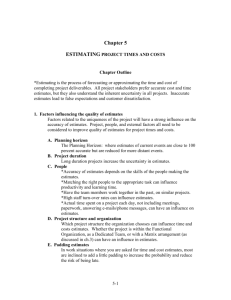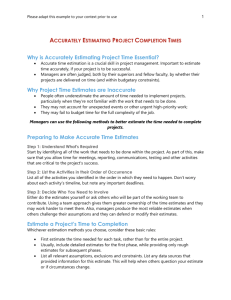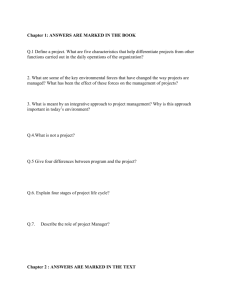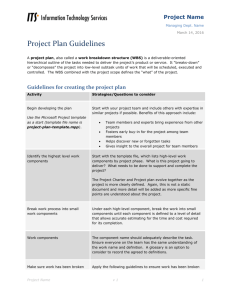ISIBP01-Project Management
advertisement
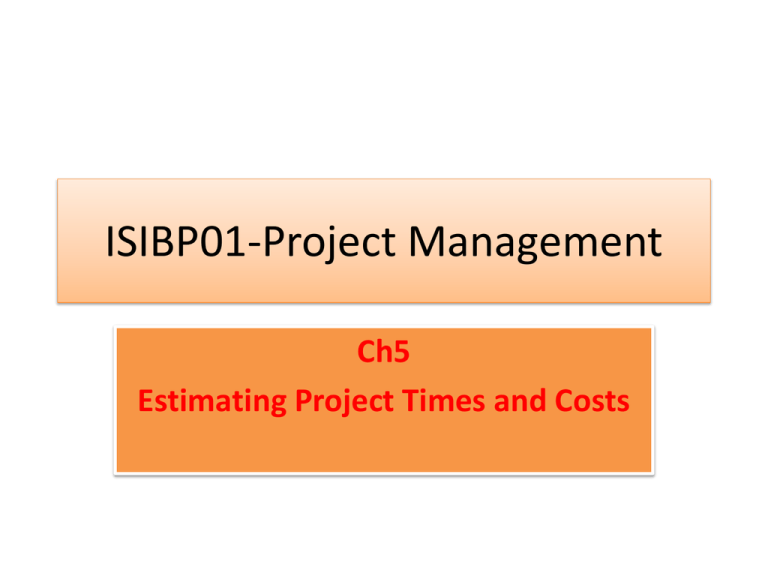
ISIBP01-Project Management Ch5 Estimating Project Times and Costs Why estimating time and cost are important? Estimates are needed: 1) To support good decisions. 2) To schedule work. 3) To determine how long the project should take and its cost. 4) To determine whether the project is worth doing. 5) To develop cash flow needs. 6) To determine how well the project is progressing. 7) To develop time- phased budgets and establish the project baseline. Factors influencing the quality of time and cost estimates 1) Planning horizon: estimate of current events is reduced for more distant events. 2) Project duration: long –duration projects increase the uncertainty in estimates. 3) People: depends on skills of the people making the estimates that a close match of skills will enhance productivity. 4) Project structure and organization: dedicated project team is gaining high speed of decision making. Also operating projects in a matrix environment may reduce costs by more efficiently sharing personnel but may take longer time to complete. 5) Padding estimates: through adding a little padding to increase the probability and reduce the risk of being late. 6) Organization culture: it shapes every dimension of project management so at some of organization estimating takes too much time and at the other, believe that the estimates are the bedrock of effective project management. 7) Other factors as National holidays, vacations, legal limits, equipment down time. Estimating Guidelines • Estimating Guidelines followed by a manager for times, costs, and resources to develop useful work package estimates: 1. Responsibility: At the work package level, estimates should be made by the persons most familiar with the task based on their expertise for getting job done on schedule and within budget by seeing the estimates materializes when implementing the work package and to build communication channels early. Those people are normally first-line supervisors or technicians. 2. Use several people to estimate: that has a better chance of being reasonable and realistic when people have relevant experience and /or knowledge of the task is used that will eliminate extreme errors. 3. Normal conditions: time will be estimated based on normal working hours per day as the normal workday is eight hours, the time estimate should be based on eight-hour day even if two-shift workday. Moreover, time and cost estimate will be based on the normal levels of resources which available as people or equipment. Estimating Guidelines 4. Time units: should be selected early in the development phase of the project network. Estimates of time must consider whether normal time is represented by calendar days, workdays, workweeks, person days, single shift, hours, and minutes. 5. Independence: Estimators should treat each task as independent of other tasks that might be integrated by the WBS. 6. Contingencies: The estimates should assume normal or average conditions. So top management needs to create an extra fund that can be used to cover unforeseen events. 7. Adding risk assessment to the estimate helps to avoid surprises to stakeholders: Some tasks such as a new technology carry more time and cost risks than a proven process so identifying the degree of risk let stakeholders consider the alternative methods and alternative process decisions. Top-down versus bottom-up estimating Top-down estimates: 1. usually are derived from someone who uses experience and /or information to determine the project duration and total cost. 2. These are sometimes made by top managers who have very little knowledge of the processes used to complete the project. 3. Top-down methods can be useful if experience and judgment have been accurate in the past. 4. The top-down estimates are not realistic because top management “wants the project” 5. It used for these conditions strategic decision making, high uncertainty, internal and small projects and unstable scope. 6. Its disadvantage that the time and cost for a specific task are not considered. Top-down versus bottom-up estimating Bottom-Up estimates: 1. It derived from the people who have most knowledge about the estimate needed. 2. The use of several people with relevant experience with the task can improve the time and cost estimate through roll-up the work packages and associated cost accounts to major deliverables. 3. It provides the customer with an opportunity to compare the lowcost efficient method such as if completion period requires 2years and bottom-up analysis tells you the project will take 2.5 years so the client can consider the trade-off of the low-cost method versus compressing the project to 2 years. 4. It used for these conditions cost and time important, fixed price contract and customer wants details. Methods for estimating project times and costs: Top-down approaches for estimating project times and costs: 1. Consensus methods: it uses the pooled experience of senior and/ or middle managers to estimate the total project duration and cost. 2. Ratio methods: it used in concept or phase of a project to get an initial duration and cost estimate for the project such as we have a house of $2700 square feet might cost $160 per square foot so the estimated cost for a total land will be multiplying of them. Other examples: a new plant estimated by capacity size, a software product estimated by features and complexity. Methods for estimating project times and costs: 3. Apportion method (Apportionment): This method is an extension to the ratio method. It used when project is closely follow past projects in features and cost. Estimates can be done quickly with little effort and reasonable accuracy. It is very common in projects but its weaknesses that it have some small variation or customization Methods for estimating project times and costs: 4. Function point methods (Complexity Weighting): it is use of complexity weighted macro variables such as number of inputs, number of outputs, number of data files and number of interfaces. These weighted variables are adjusted for a complexity factor and added. The total adjust account provides the basis for estimating the labor effort and cost for a project. It could be done based on the historical data then using regression formula. 5. Learning (improvement)(experience)( industrial progress) curves: Some projects require that the same task, group of tasks or product to be repeated several times so a perform a task improves with repetition. Each time the output quantity doubles, the unit labor hours are reduced at a constant rate. Micro estimated method is more accurate than Macro methods. Methods for estimating project times and costs: Bottom-up approaches for estimating project times and costs: 1. 2. 3. Template method: If the project is similar to the past projects, the costs from past projects can be a starting point for the new project. Differences from the appropriate standardized project are noted (for times, costs and resources) and changes are made. This allows developing a potential schedule, estimating costs and developing budget in a very short time span. Parametric procedures: Just as a parameter techniques such as cost per square foot can be applied to specific task. Detailed estimates for the WBS work packages: The most reliable method for estimating time and cost is to use WBS and ask people for responsible for work package to make the estimated especially from their experience. Level of detail • It is different from levels of management. • At detail level, should be no more than is necessary. • Its purpose in the WBS is to match management needs for effective implementation. • Excessive detail means more unproductive paperwork. Types of Costs found in a project: 1. Direct costs: represent real cash outflows and must be paid as the project progresses. Lower-level project rollups only direct costs. It is separated from overhead costs. 2. Direct overhead costs: It more closely to resources of the organization is being used in the project. It can be tied to project deliverables or work packages such as the salary of the project manager and temporary rental space for the project team. It is not an immediate run out of pocket expense, it is real and must be covered in the long run if the firm is to remain viable. 3. General and administrative overhead costs: It is not directly linked to a specific project. It is carried for the duration of the project. Examples such as advertising, accounting, and senior management above all project level. Refining estimates • Since there is inherent uncertainty of predicting the future we have many reasons as the following: 1. Interaction costs are hidden in estimates: because of disconnect between tasks. 2. Normal conditions don’t apply: because availability of resources, as people, equipment or materials may include shortage than normal condition that can extend original estimates. 3. Things go wrong on projects: Design flaws are revealed after the fact, extreme weather conditions occur, accidents happen and so forth. 4. Changes in project scope and plans: As one gets further and further into the project, a manager obtains a better understanding of what needs to be done to accomplish the project. Changes have to be made at midstream to respond to new demands by the customers or competition. Creating a Database for Estimating: • The best way to improve estimates is to collect and archive data on past project estimates and actual. • Saving historical data provides knowledge base for improving project time and cost estimating. Problems Solving Problems Solving Problems Solving Problems Solving Problems Solving




